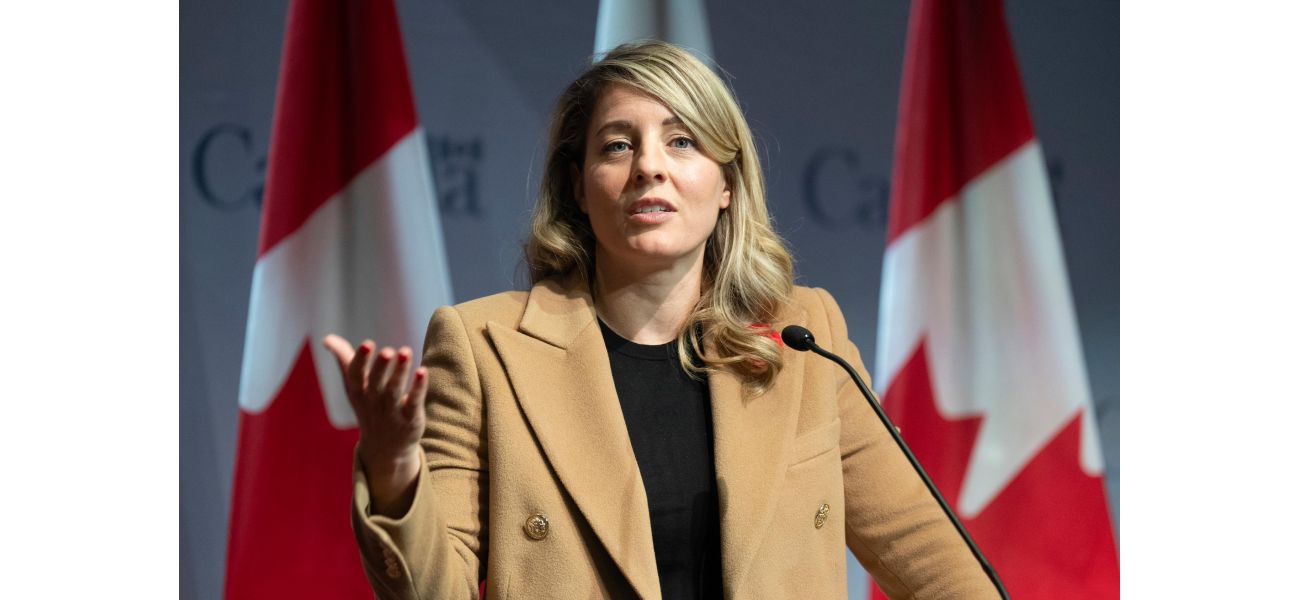Canada's Cabinet officials discuss with US President's pick for commerce secretary to prevent tariffs.
Canadian ministers leave Mar-a-Lago meeting without reassurance on Trump's tariff threats against Canada.
December 28th 2024.

Two Cabinet ministers from Canada recently attended a meeting at Mar-a-Lago on Friday, but they left without any assurance from President-elect Donald Trump that he would back down on his threat to impose tariffs on all products from Canada, which is one of America's biggest trading partners. Despite calling the talks "productive," it seems that the Americans are still focused on the U.S. trade deficit with Canada.
The Canadian ministers, Dominic LeBlanc and Mélanie Joly, had a meeting with Howard Lutnick, Trump's nominee for commerce secretary, and Doug Burgum, Trump's pick for the Interior Department. The main issue discussed was Trump's threat to impose a 25% tariff on Canadian products if Canada does not take measures to stop the flow of migrants and fentanyl into the U.S. However, statistics show that significantly fewer migrants and fentanyl cross into the U.S. from Canada compared to Mexico, which Trump has also targeted with tariffs.
According to Jean-Sébastien Comeau, a spokesperson for LeBlanc, the meeting was a follow-up to the dinner between Prime Minister Justin Trudeau and President Trump last month. Both ministers outlined Canada's billion-dollar plan to increase security at the border and reiterated their commitment to combat the harm caused by fentanyl and save lives in both countries. Lutnick and Burgum agreed to relay this information to Trump.
However, a senior Canadian official, who spoke on the condition of anonymity, revealed that the Americans are still fixated on the U.S. trade deficit with Canada and want it to decrease. This official also stated that Trump has been misinformed about the deficit, erroneously calling it a subsidy.
Kirsten Hillman, Canada's ambassador to Washington, has clarified that the U.S. had a $75 billion trade deficit with Canada last year, but nearly a third of what Canada sells into the U.S. are energy exports. She also pointed out that there is a deficit only when oil prices are high. It is worth mentioning that about 60% of U.S. crude oil imports and 85% of U.S. electricity imports are from Canada. In fact, Alberta alone sends 4.3 million barrels of oil per day to the U.S. which consumes about 20 million barrels a day.
The Trump transition team did not respond immediately to a request for comment, but it is expected that further discussions will take place in the coming weeks. Joly also has plans to have dinner with U.S. Senator Lindsey Graham on Friday.
In recent weeks, Trump has been using social media to troll Prime Minister Trudeau by calling him the Governor of the 51st state. Trudeau has not directly responded, but he did share a link on Thursday to a six-minute video from 2010 where American journalist Tom Brokaw explains Canada to Americans. In the video, Brokaw talks about the strong relationship between the two countries, the massive trading partnership, and Canada's contribution in World War 2 and Afghanistan. He also mentions that in times of crisis, Canada has always stood by the U.S.
Trudeau has also warned Trump that Americans would also suffer if he follows through on his plan to impose tariffs on Canadian products. It is important to note that nearly $3.6 billion Canadian dollars worth of goods and services cross the border every day. Canada is the top export destination for 36 U.S. states.
The situation at the two land borders of the U.S. is vastly different. While U.S. customs agents seized 43 pounds of fentanyl at the Canadian border in the last fiscal year, they seized a staggering 21,100 pounds at the Mexican border. The majority of fentanyl reaching the U.S. is produced by Mexican drug cartels using chemicals smuggled from Asia. When it comes to immigration, the U.S. Border Patrol reported 1.53 million encounters with migrants at the southwest border with Mexico, while there were only 23,721 encounters at the Canadian border during the same period.
The Canadian ministers, Dominic LeBlanc and Mélanie Joly, had a meeting with Howard Lutnick, Trump's nominee for commerce secretary, and Doug Burgum, Trump's pick for the Interior Department. The main issue discussed was Trump's threat to impose a 25% tariff on Canadian products if Canada does not take measures to stop the flow of migrants and fentanyl into the U.S. However, statistics show that significantly fewer migrants and fentanyl cross into the U.S. from Canada compared to Mexico, which Trump has also targeted with tariffs.
According to Jean-Sébastien Comeau, a spokesperson for LeBlanc, the meeting was a follow-up to the dinner between Prime Minister Justin Trudeau and President Trump last month. Both ministers outlined Canada's billion-dollar plan to increase security at the border and reiterated their commitment to combat the harm caused by fentanyl and save lives in both countries. Lutnick and Burgum agreed to relay this information to Trump.
However, a senior Canadian official, who spoke on the condition of anonymity, revealed that the Americans are still fixated on the U.S. trade deficit with Canada and want it to decrease. This official also stated that Trump has been misinformed about the deficit, erroneously calling it a subsidy.
Kirsten Hillman, Canada's ambassador to Washington, has clarified that the U.S. had a $75 billion trade deficit with Canada last year, but nearly a third of what Canada sells into the U.S. are energy exports. She also pointed out that there is a deficit only when oil prices are high. It is worth mentioning that about 60% of U.S. crude oil imports and 85% of U.S. electricity imports are from Canada. In fact, Alberta alone sends 4.3 million barrels of oil per day to the U.S. which consumes about 20 million barrels a day.
The Trump transition team did not respond immediately to a request for comment, but it is expected that further discussions will take place in the coming weeks. Joly also has plans to have dinner with U.S. Senator Lindsey Graham on Friday.
In recent weeks, Trump has been using social media to troll Prime Minister Trudeau by calling him the Governor of the 51st state. Trudeau has not directly responded, but he did share a link on Thursday to a six-minute video from 2010 where American journalist Tom Brokaw explains Canada to Americans. In the video, Brokaw talks about the strong relationship between the two countries, the massive trading partnership, and Canada's contribution in World War 2 and Afghanistan. He also mentions that in times of crisis, Canada has always stood by the U.S.
Trudeau has also warned Trump that Americans would also suffer if he follows through on his plan to impose tariffs on Canadian products. It is important to note that nearly $3.6 billion Canadian dollars worth of goods and services cross the border every day. Canada is the top export destination for 36 U.S. states.
The situation at the two land borders of the U.S. is vastly different. While U.S. customs agents seized 43 pounds of fentanyl at the Canadian border in the last fiscal year, they seized a staggering 21,100 pounds at the Mexican border. The majority of fentanyl reaching the U.S. is produced by Mexican drug cartels using chemicals smuggled from Asia. When it comes to immigration, the U.S. Border Patrol reported 1.53 million encounters with migrants at the southwest border with Mexico, while there were only 23,721 encounters at the Canadian border during the same period.
[This article has been trending online recently and has been generated with AI. Your feed is customized.]
[Generative AI is experimental.]
0
0
Submit Comment





